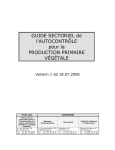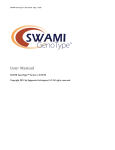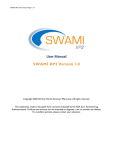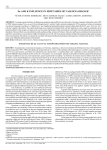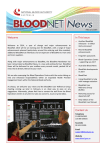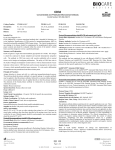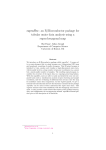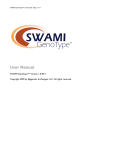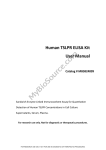Download Complete collection - INTEGRA Biosciences
Transcript
Trouble shooting and FAQ 4 Trouble shooting and FAQ 1. Why is it that removal or addition of cell compartment volume is slow? Why does cell compartment volume come back out of port when I remove the pipette? Be sure that the medium compartment cap is loosened during manipulation of the cell compartment volume. Changes in cell compartment volume create pressure in the nutrient compartment if the cap is not loosened. Tighten cap after cell compartment manipulation is complete. 2. When I pour medium from the CELLine, I sometimes have a drop of medium left on the outside of the neck, what can I do to stop this from happening? When pouring medium from the CELLine it is recommended that the flask be held with the bottom of the flask in the palm. This provides adequate neck pouring angle and prevents accumulation of the medium on lip of neck after pouring. The angle of the neck on the CELLine is required to prevent air locks in the nutrient reservoir and thus pouring is best done with flask upside down in palm of hand. 3. After incubation, I notice that the outside of the CELLine is wet, why is this? If medium is placed in flask that is not pre-warmed, there will be considerable condensation accumulation on the outside of the CELLine. Due to the large volume of medium contained in the CELLine, this condensation can be significant. The condensate takes time to evaporate in the humidified incubator. Test color of liquid by blotting with white paper, if there is no coloration, the liquid is water and due to condensate. 4. Can I place more than the recommended volumes into the cell compartment? The protocol recommends a working volume of 5 ml (CL 350), and 15 ml (CL or AD 1000) for the CELLine products. This assures that volume in the cell compartment never exceeds bursting threshold for the membrane even with osmotic flux of water into the cell compartment over an extended period. The membrane is fragile but compliant and will distend significant distance when wet. Increased cell compartment volumes up to 1.3 times above recommendation are not problematic. 12 User Manual CELLine 2003 When working with cells growing in suspension in CELLine classic, the recovery of cells from the cell compartment should be nearly 100%. Suspension cell types have not been observed to form aggregates and are readily disbursed with gentle pipetting. Following pipetting the cells are easily recovered. An additional rinse of clean medium may be used to further assure complete cell recovery if required. Other cells types may form cellular aggregates or attach to the bottom of the cell compartment. In these cases, cell recovery may require the use of a dissociating agent to separate cells and to aid in their recovery. When working with anchorage-dependent cells in CELLine adhere, cell are attached to the PET ilay matrix. Depending on the individual cell type, sometimes recovery of the cells can be achived mechniaclly by pipetting up and down, but in most of the cases a complete recovery involves the addition of a dissociating agent to the cell compartment. Trouble shooting and FAQ 5. Will I be able to recover all of my cells from the cell compartment? 6. Can I change nutrient medium by tracking color change of the nutrient medium as I do in my other cultures? It is not recommended. Cell growth is dependent on the diffusion gradients present between the cell compartment and nutrient medium compartment. The greater the gradient, the larger the flux of soluble metabolic substrates that is available for cell metabolism. The medium color change is not an accurate assessment of nutrient and waste status in the CELLine due to the ability of the cell compartment to balance pH directly with the incubator atmosphere. Nutrient medium will become more yellowish during culture but will not take on the characteristic color associated with spent medium in traditional flasks. Careful tracking of cell numbers within the cell compartment and medium exchange rate can be done to determine optimum conditions for your cell type. 7. When I harvest from the cell compartment, I always have a greater volume than what I inoculated why is this happening? Osmotic gradients across the upper semi-permeable membrane will drive water through the membrane. If a protein gradient is present across the semi-permeable membrane such as when no serum is used in the nutrient compartment, water is driven into the cell compartment. Because small solutes will move across the membrane also, this change in volume only affects colloid protein concentrations. This is the reason for the recommended use of 15% serum in the cell compartment when no serum is used in the nutrient medium, as it assures that serum concentrations with in the cell compartment do not become excessively diluted with continued culture. INTEGRA Biosciences 13 Trouble shooting and FAQ 8. The cell compartment volume in my CELLine is less than what I inoculated, where is the volume going? If the CELLine is used in a non humidified incubator or warm room, evaporative losses from the cell compartment can lead to reduced volumes. The CELLine is intended to be used in a standard humidified incubator. If required it may be worth evaluating restricting the bottom gas vents to reduce evaporation. This should be done experimentally to determine the balance between evaporative loss and adequate gas exchange. 9. How much nutrient medium can I place in the nutrient reservoir? The maximum capacity of the reservoir is marked on the sides of the devices. For the CL 350 (350 ml) and for the CL or AD 1000 (1000 ml) are the maximum volumes. Do not exceed these volumes as the design requires that there be an air passage to the green cap. If excess medium is placed in the devices, an air lock can be created within the reservoir compartment. 10. I notice that the distribution of cells in the cell compartment sometimes is not even across the bottom of the cell compartment, should I mix the cell compartment to provide a more even distribution? This is not necessary, experiments which involved re-suspending cells in the cell compartment did not lead to increased cell numbers or antibody production. An excessive accumulation of cells in one area of the CELLine due to a non-level incubator should however be disbursed and allowed to resettle. 11. I have followed the protocol and my cells are not growing, what is wrong? Check to be sure that the protocol has been adhered to. The condition of the cells prior to inoculation is critical. Cells should be taken from logarithmic growth and inoculated at the required cell numbers. Be sure the minimum cell numbers for inoculation are present. Absence of hybridoma cell growth has been seen under certain conditions. Poor growth has been associated with mycoplasm contamination. Mycoplasm accumulates within the cell compartment and may exert effects not seen in static culture flasks. Treat cells to eradicate the mycoplasm and robust cell growth should be established. There may be some cells that are not capable of growth in the absence of serum components which can diffuse across the upper semi-permeable membrane. Increasing serum concentrations in the nutrient medium and or cell compartment can be evaluated to determine if this is required. Finally, if insufficient numbers of cells are inoculated, there may be a significant lag phase prior to cell proliferation. It is recommended that a new inoculum with higher numbers of cells be placed in the cell compartment and results evaluated. If cells require a conditioning factor that diffuses across the membrane it may be necessary to start with a small volume in the nutrient medium compartment until cell numbers increase. When cell growth is established adequate nutrient medium must be added to supply the increasing cell mass. 14 User Manual CELLine 2003 Yes, cultures in the cell line will be under the same CO2 tensions as in static flasks. Use of a medium formulated for use in 7.5% CO2 is required. 13. I can not view cells in the CELLine using my inverted microscope, what can I do to be able to view them? Due to to PET matrix inlay in CELLine adhere cells can not be viewed under a microscope. For CELLine classic bioreactors, the microscope objective must travel above the stage of the microscope to allow for viewing into the cell compartment. If you have a mechanical articulated stage or other attachments on the microscope, it may be required to remove them. Alternatively, the objective can be un-threaded from the nose piece several turns to allow sufficient travel up past the plane of the stage. Additionally, the working distance of the objective must be sufficient, most 10X and some 20X objectives are suitable. The distance from objective to CELLine is 2.5 mm both for the classic 350 and 1000 reactors. Trouble shooting and FAQ 12. Will the CELLine function in a 7.5% CO environment? 14. I have viewed my cells in the CELLine classic but when I tried to view them again after several days of culture I was not able to focus on them, what has changed? When the CELLine is removed from the incubator and the temperature of air in the CELLine is cooled slightly, contraction of the air takes place and will draw the membranes of the cell compartment up into the device. This contraction lifts the bottom membrane and takes it out of focusing distance. The loosening of the medium compartment cap will equilibrate pressure and return membrane to original position. 15. How strong is the semi-permeable membrane? The upper semi-permeable membrane is only 8 µm thick (dry). The membrane is delicate but easily withstands normal handling. Shaking or banging of flask against hand or surface can lead to membrane failure if the cell compartment has liquid in it. This places significant stress on the membrane due to the rapid displacement of the liquid present in the cell compartment. 16. Why is it recommended to wet the membrane before placing cells into the cell compartment? It is important to wet the membrane prior to inoculation to assure that the membrane is compliant. The wet membrane is compliant and capable of distension. The dry membrane is more susceptible to tensile stress due to volume changes. The air trapped in the cell compartment can not be removed until the membrane is wet and liquid is added into the cell compartment. The dry membrane is stressed significantly if volume is added directly into the cell compartment prior to wetting of membrane. INTEGRA Biosciences 15 Trouble shooting and FAQ 17. Does the semi-permeable membrane become clogged with use? Performance of the CELLine devices does not decrease with time of culture. This indicates that solute transfer across the membrane does not decrease significantly during culture and there is thus no significant clogging or fouling of the membrane. 18. Are there different membranes available for the CELLine? Currently, only a 10,000 MWCO membrane is available. 19. Do you have any tips on handling which will reduce the risk of contamination? Every time the culture is handled the sterile field is broken to add and remove cells and medium. The medium is easiest removed using a Vacuum system like the INTEGRA VACUSAFE. In case the medium is simply poured out, drops on the neck of the bottles should be remove using a sterile Pasteur pipette and should not be wiped off with alcohol. Its recommended to perform all working steps with CELLine in a Class II biosafty cabinet. Cleaning of working surfaces with alcohol can provide additional protection against contamination risk. Sterile alcohol wipes or spray alcohol is routinely used to reduce contamination risk in many laboratories. There has been no indication that this produces adverse effects on the device itself or on cell growth in the devices. 20. Are there any special storage conditions required for unopened CELLine products? The devices are packaged in a sterile barrier blister within a foil vapor barrier pouch. Great care has been taken to provide as robust a package as possible. The devices can be stored under ambient conditions with no demonstrated deterioration in performance. Care should be taken to prevent the devices from being exposed to high temperature to prevent dimensional changes in the membrane and excessive tensile stress. It is recommended that devices be stored at room temperature. 21. Will my hybridoma stop secreting after prolonged culture in the CELLine? We have no data that indicates selection of non-secreting clones takes place during culture in the CELLine. Even for low antibody secreting cells, no evidence has been found indicating that selection for non-secreting cells takes place. Importantly, a low secreting hybridoma will not revert to a high secretor when cultured in the CELLine. However, in many cases, a low secretor can be tolerated due to the increase in product concentration achieved with the CELLine. In many instances, cells which have very low production can be salvaged by culture in the CELLine allowing useable amounts of product to be recovered without excessive amounts of culture supernatant processing. 16 User Manual CELLine 2003 Analysis by flow cytometry indicates that antibody produced in the CELLine yields equivalent binding per mg (fluorescent profiles) when compared to control antibody cultured in static culture flasks recovered without excessive amounts of culture supernatant processing. 23. How many cells can be cultured in the CELLine? For a typical murine hybridoma the viable cell concentrations reached in CELLine are around 2 - 3 x 107 cells/ml A fundamental principle of the CELLine is the cell capacity of the devices. If adequate nutrient medium exchange is provided, cell proliferation will continue within the cell compartment even when maximum viable cell capacity has been reached. This can result in very large numbers of total cells within the device. For the production of antibody total cell accumulation is not problematic. Trouble shooting and FAQ 22. Is the antibody produced in the CELLine classic equivalent to antibody produced in static culture? 24. Can I culture leukemic cell lines in the CELLine? Lymphoblastic cells grow very well in the CELLine classic. Cell concentrations of certain lymphoblastic cells can reach nearly twice that achieved for hybridoma cells. Some cell lines may be dependent upon the use of serum on both sides of the semi-permeable membrane and this can be readily examined. 25. Do you recommend the use of a high glucose containing medium in the CELLine? Most protocols were developed using standard RPMI-1640 medium. Some customers and others who use hollow fiber bioreactors do use richer mediums. A slight performance increase may be obtained with richer media, however, this is dependent upon cell line and should be evaluated experimentally. In general excellent results are obtained in medium which is currently used to culture the cell line in static flasks. 26. Will serum free medium work in the CELLine? Yes many customers report excellent results using serum free medium. The serum free medium is placed on both sides of the semi-permeable membrane in most cases. Importantly, the use of serum free medium may no longer be necessary when the CELLine is used. As the secreted protein is recovered at high concentration from the CELLine, it is no longer necessary to concentrate culture supernatant to recover antibody. This eliminates much of the interference associated with serum protein during purification. At antibody concentrations in excess of mg/ml, cell compartment supernatant can be applied directly to an affinity column. INTEGRA Biosciences 17







